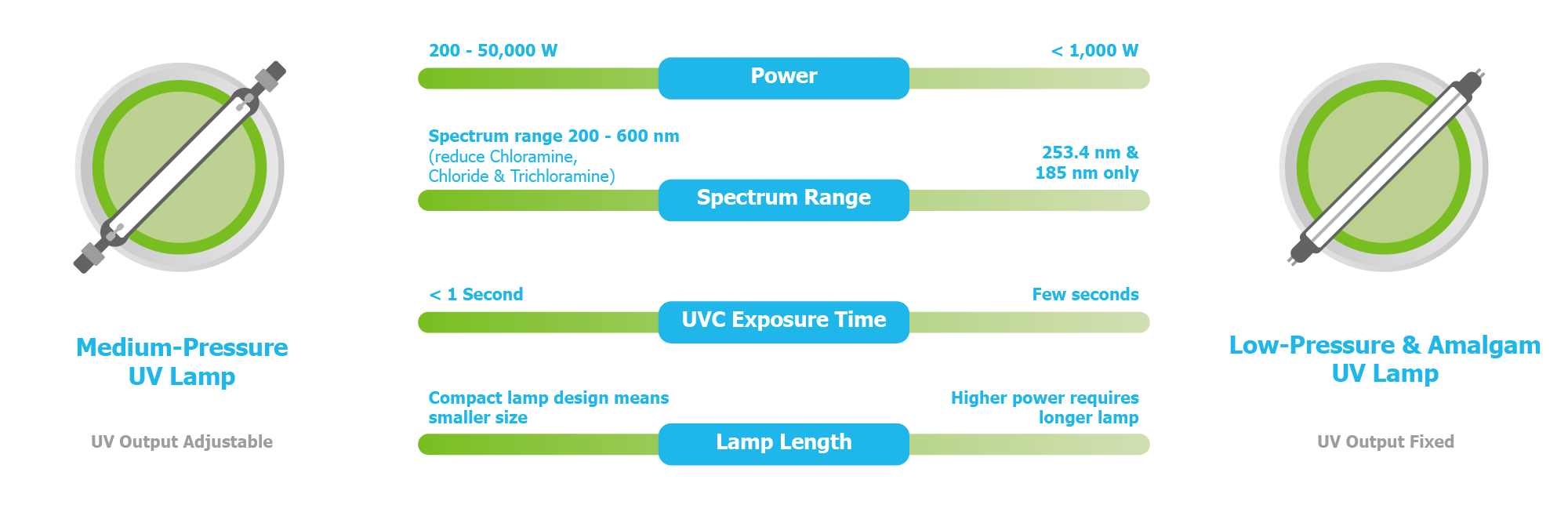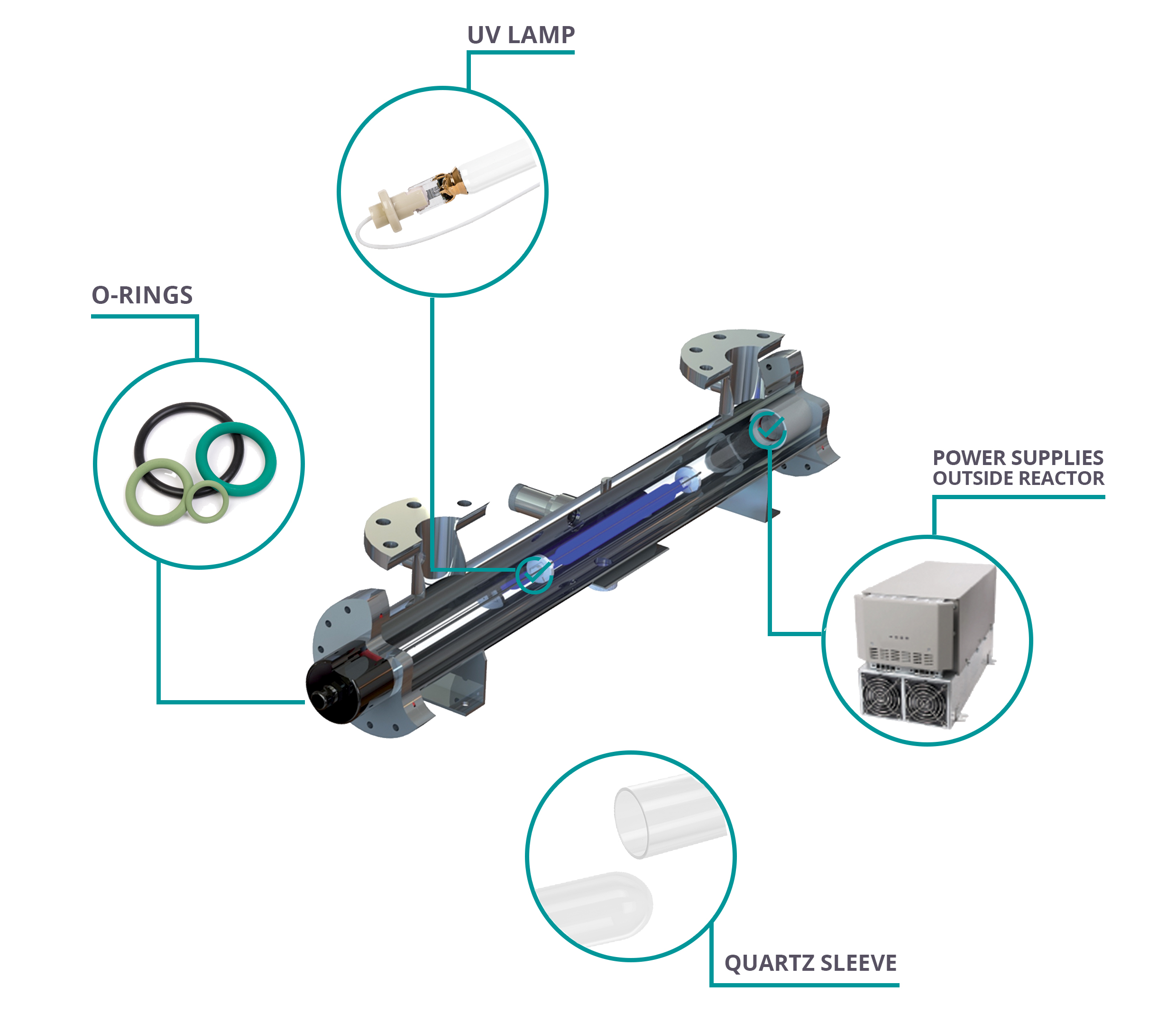Posted: Monday, 5 August 2024
Ultraviolet (UV) disinfection is a proven technology for purifying water across a range of applications, from municipal water treatment to industrial processes. The two primary types of UV lamps used in these systems are low-pressure and medium-pressure UV lamps. Both have their unique strengths and considerations, but which one is better suited for water disinfection? Let's get into the details!
Understanding the Basics: Low-Pressure vs. Medium-Pressure UV Lamps
Low-Pressure UV Lamps
 Low-pressure UV lamps are known for their long, slender design and lower power consumption. These lamps typically emit UV light at a monochromatic wavelength of 253.7 nm, which is highly effective at inactivating microorganisms by disrupting their DNA. The power output of low-pressure lamps is usually less than 1000 watts, making them energy-efficient options, especially for systems where power consumption is a key concern.
Low-pressure UV lamps are known for their long, slender design and lower power consumption. These lamps typically emit UV light at a monochromatic wavelength of 253.7 nm, which is highly effective at inactivating microorganisms by disrupting their DNA. The power output of low-pressure lamps is usually less than 1000 watts, making them energy-efficient options, especially for systems where power consumption is a key concern.
Medium-Pressure UV Lamps
In contrast, medium-pressure UV lamps are shorter and can emit a broader spectrum of UV light, ranging between 200-600 nm. These lamps are capable of delivering a much higher power output, ranging from 200 watts to as much as 50,000 watts. This broad spectrum of UV wavelengths can target a wider range of microorganisms and other contaminants, making medium-pressure lamps highly effective in more demanding water disinfection applications.
Low vs. Medium-Pressure Lamp Comparison Table:

Disinfection Capabilities: DNA Damage and Inactivation
 When it comes to disinfection, the effectiveness of a UV lamp is measured by its ability to inactivate microorganisms, which is achieved by damaging their DNA or RNA. Low-pressure UV lamps, operating at 253.7 nm, are effective in disrupting the DNA of a wide range of microorganisms, preventing them from replicating. However, there is a risk of DNA repair, where certain microorganisms might recover and continue to pose a threat.Medium-pressure UV lamps, with their broad spectrum of wavelengths, cause more extensive damage to the DNA and other cellular components of microorganisms. This reduces the chances of DNA repair and ensures a higher level of disinfection. For example, pathogens like Cryptosporidium and Bacillus subtilis spores are more effectively inactivated at specific wavelengths within the range of medium-pressure UV lamps, such as 270-280 nm.
When it comes to disinfection, the effectiveness of a UV lamp is measured by its ability to inactivate microorganisms, which is achieved by damaging their DNA or RNA. Low-pressure UV lamps, operating at 253.7 nm, are effective in disrupting the DNA of a wide range of microorganisms, preventing them from replicating. However, there is a risk of DNA repair, where certain microorganisms might recover and continue to pose a threat.Medium-pressure UV lamps, with their broad spectrum of wavelengths, cause more extensive damage to the DNA and other cellular components of microorganisms. This reduces the chances of DNA repair and ensures a higher level of disinfection. For example, pathogens like Cryptosporidium and Bacillus subtilis spores are more effectively inactivated at specific wavelengths within the range of medium-pressure UV lamps, such as 270-280 nm.
Power Efficiency: A Balanced Perspective
Low-pressure UV lamps are often touted for their energy efficiency, given their lower power consumption and high UV output per watt. This makes them ideal for applications where energy savings are a priority. However, medium-pressure UV lamps, despite their higher power consumption, can compensate for this with their high-intensity output and the ability to cover a broader range of pathogens and contaminants. Additionally, modern medium-pressure systems often include power regulation features that optimize energy use, making the overall system efficiency comparable to that of low-pressure systems.
Operational Considerations: System Design and Maintenance

In terms of system design and maintenance, medium-pressure UV systems can offer several advantages. Because they emit a higher intensity of UV light, fewer lamps are required to achieve the desired level of disinfection. This results in a more compact system design, which can reduce the initial capital investment and ongoing maintenance costs. It also means the system requires a smaller footprint which can be very useful when adding a UV based system to existing infrastructure. Fewer lamps also mean fewer replacements over time, potentially further lowering the total cost of ownership.
Low-pressure systems, while requiring more lamps, can be advantageous in applications where space is not a constraint, and where lower power consumption is a priority. However, the need for more lamps can increase maintenance complexity and costs over time.
Conclusion: Which is Better?
Both low-pressure and medium-pressure UV lamps have their unique advantages and are well-suited to different applications. Low-pressure lamps offer energy efficiency and simplicity, making them ideal for smaller systems or applications where energy savings are critical. Medium-pressure lamps, on the other hand, provide broader disinfection capabilities, better pathogen inactivation, and more compact system designs, making them preferable for more demanding applications.
Ultimately, the choice between low-pressure and medium-pressure UV lamps should be based on specific system requirements, including the type of microorganisms to be targeted, system size, energy considerations, and overall cost-effectiveness.
If you're looking to understand more about the differences between these UV lamps and how they can be applied to your water disinfection system, Alpha-Purify offers a range of both medium and low-pressure UV lamps (and accessories) tailored to your needs.
Contact Us today to learn more.
This is an update on a blog first published in September 2018.
External References used for this blog: